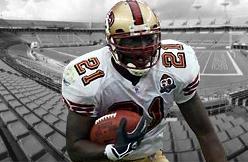San Francisco 49ers' offense lacked subtlety under former coach Mike Singletary. That was the point. Singletary vowed to "hit people in the mouth" with a power running game.
If opponents loaded up against the run, too bad. The 49ers were going to establish physical dominance anyway. That was the mentality.
The 49ers' new coaching staff shares similar values, with a twist: more sophisticated run-game scheming from coach Jim Harbaugh.
"It's not that my running style will change," running back Frank Gore told Jonathan Jones of SI.com. "He's just going to get me catching the ball more and getting me a lot of space. He'll be doing a lot of different things instead of [running against] the eight or nine men in the box. He's just trying to get the box loosened up for me."
Questions arose upon reading that passage. How effective were the 49ers running against defenses with eight or more defenders in the box? Did Gore run against these fronts a disproportionate amount of the time? Might a shift in approach help extend his career?
Jason Starrett of ESPN Stats & Information came through with a file showing how NFL teams and running backs have fared in these situations over the past two seasons. I'll break out some of the findings below.
1. Gore was leading the NFL in yards per carry last season against defenses showing eight or more defenders in the box.
Twenty-three players had at least 25 carries in these situations through Week 12 last season, when Gore suffered a season-ending hip injury.
ore ranked only 19th on the list with 26 such carries, but he averaged an impressive 6.4 yards per attempt on them. That was the highest average among players with at least 25 attempts against these fronts.
The Pittsburgh Steelers' Rashard Mendenhall led the NFL with 70 such carries. He was among eight players with at least 45.
Mendenhall faced eight or more in the box on 29.4 percent of his carries through Week 12, compared to only 12.8 percent for Gore.
Such percentages vary for backs across the league. The Houston Texans' Arian Foster, who ranked second to Mendenhall with 57 carries against defenses with at least eight defenders in the box through Week 12, was at 25.4 percent. Seattle's Marshawn Lynch was at 24 percent. The St. Louis Rams' Steven Jackson was at 13.8 percent.
Brandon Jacobs (5.7), Adrian Peterson (5.6) and Chris Ivory joined Gore in averaging at least five yards per carry on these runs.
The seven lowest averages: Cedric Benson (1.3), Lynch (1.7), Marion Barber (1.7), Jackson (2.1), LaDainian Tomlinson (2.1), Ray Rice (2.4) and Chris Johnson (2.5).
The stats do not take into account variables such as down, distance, game situation or personnel groups. They tell us Gore wasn't especially likely to run the ball against defenses with eight or more defenders in the box.
2. Gore's carries against defenses showing eight or more defenders in the box have declined recently.
In 2009, Gore carried 84 times for 358 yards and a 4.3-yard average against these defenses. That worked out to six such carries per game for the 14 games Gore played. The average fell to 2.4 per game last season.
What changed from 2009 to 2010?
The 49ers changed offensive coordinators early in the 2010 season. Troy Smith brought a boom-or-bust dynamic to the offense for a while. The 49ers also added about five snaps per game with more than two wide receivers on the field, inviting different looks from opposing defenses. Gore's short-yardage carries did not vary much.
The offensive line changed.
First-round draft choices Mike Iupati and Anthony Davis started as rookies, with Iupati quickly establishing himself as an emerging player. David Baas took over at center. Right guard Chilo Rachal stood out to Pro Football Focus for improved run blocking. And rookie Nate Byham showed signs of becoming one of the better blocking tight ends in the league.
No matter the reason, Gore's carries against stacked fronts were already on the decline.
3. The number of blockers available matters, but the stats are confusing.
ESPN Stats & Information charts box counts apart from whether or not boxes were "loaded" with more defenders than available blockers.
Improbably, the 49ers led the NFL in 2009 with a 5.4-yard average against loaded boxes featuring at least eight defenders. They ranked only 29th that year with a 2.2-yard average when facing eight or more in the box in "unloaded" situations that should have proven more favorable.
This makes little sense on the surface.
The stats flipped in 2010. San Francisco ranked 25th with a 2.5-yard average against loaded boxes featuring at least eight defenders. They ranked second only to Houston with a 5.4-yard average when facing eight or more in the box in unloaded (more favorable) situations.
This makes more sense.
It's possible the 49ers' reliance on heavier personnel -- formations featuring two backs and/or two tight ends -- affected their averages in unexpected ways. For now, though, I'm not drawing any conclusions from the "loaded" and "unloaded" breakdowns.
They're a load of confusion at this point.
4. These stats included information of interest for teams other than the 49ers. More on that in a separate item (or two).
For example, the Arizona Cardinals' Beanie Wells faced less favorable running situations a very high percentage of the time.
Click here to order Frank Gore’s proCane Rookie Card.

(espn.com)



